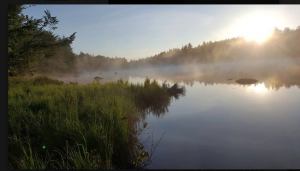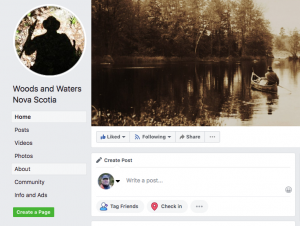It’s good news for sure, but doesn’t reduce the demand to see changes, à la Lahey Report, in management of all Crown land currently subject to harvest

Photo from Protect the Ingram River Wilderness Area
On Healthy Forest Coalition Facebook Page:
ML: I hope that this case serves as an example of the benefits of engaging in the public process. Minister Iain Rankin, you have the utmost thanks of the St. Margaret’s Bay community for acknowledging the significance of this area to our community and ecological systems that are in such need of preservation.
Obviously, there are flaws in the process and most would like to see the process improved, but let this be a call to action; differences can be made with enough persistence.
Although this assessment represents a great stride in the right direction, the fight to protect the Ingram River Wilderness Area is far from over. We will continue to need support from other organizations, the public, and politicians.
Emails and letter of support will always go a long way to show that you also want to see the Ingram River Wilderness Area designated. Please help support this reasonable request to protect 9 % of the St. Margaret’s District.
with reference to a post on Protect the Ingram River Wilderness Area:
The St. Margaret’s Bay Stewardship Association (SMBSA) is thrilled about the announcement on Friday, January 11 of a Wilderness Assessment for the proposed Ingram River Wilderness Area (IRWA). The SMBSA extends its heartfelt thanks to Minister of Lands and Forestry, Iain Rankin, for taking the next steps in preserving the ecological and community values that are so important in the proposed Wilderness Area.
Conducted in partnership between the Department of Lands and Forestry and Nova Scotia Environment, SMBSA Chair, Nick Horne, says, “We’re confident this assessment will highlight, not only the pockets of old forest, with high conservation value, but also the extremely high social value this area holds for our community.” Horne adds that the very high conservation value of the area was recently further demonstrated when, he says, “A stand of eastern hemlock that has probably never been harvested with many trees over 200 years old identified, an extreme rarity and a very exciting find in Nova Scotia.”
The SMBSA says the planned assessment shows that both the Department of Lands and Forestry and Nova Scotia Environment understand the tremendous potential of the proposed IRWA to support the provincial goals of land protection, and the area’s role to support community values, such as hunting, hiking, Off-HWY-Vehicle use, canoeing, and kayaking.
Although this Wilderness Assessment is exactly what the area needs, and what the SMBSA has been requesting for many years, Horne adds that the Association is “deeply concerned that additional harvests are to take place even as the assessment is being conducted,” adding, “It seems most appropriate that all harvests in the proposed Wilderness Area be deferred while the study is underway. Any forest harvests occurring during the study period will impact the findings and conclusions.
The SMBSA notes the protection of the IRWA doesn’t mean the St. Margaret’s District (of the former Bowater-Mersey lands) will be unbalanced, leaning too heavily towards land protection, as the proposed Wilderness Area comprises roughly 9 percent of the entire District. This allows for the continuation of forestry operations in the remaining 91 percent. Says Horne, “Our Association sees the request that the province protect the Wilderness Area as more than reasonable to ensure that a balance between preservation and industry is achieved, and ecological and community values are preserved in the area.”
The designation of the IRWA will also bring the District closer to the recommendations of the Lahey Report. Currently, the St. Margaret’s Bay District has only an 8 percent protection rate, while the Lahey Report calls for closer to 30 percent, using the triad approach to balanced land and forest management.
Horne says, “The St. Margaret’s Bay Stewardship Association is looking forward to working closely with both the Department of Lands and Forestry and Nova Scotia Environment to ensure that this assessment is holistic and all-encompassing, and that it accurately assesses the value of the proposed Ingram River Wilderness Area.”
Comments on HFC post Jan 15, ~2 pm:
BW: This sounds promising. Kudos to all who have helped to bring about this assessment. I hope the results will be favourable and that a large part of the IRWA will receive long-lasting and effective protection. If any area was deserving of such, it is certainly wothy. In the meantime, yes, we should all take time to offer support for the IRWA in the hope that the area will achieve a protected status. Nice to see some good news for a change. Gives a glimmer of hope to those of us who care about the land.
EW: Good…good
RG: Certainly a great start, now let’s see lots more.
JG: NICE!!! that is exciting!
DGP (nsforestnotes) Indeed, to be celebrated and giving credit where credit is due. I have no doubt Minister Rankin wanted to see this area protected; it’s his back yard, he knows it and undoubtedly loves it well and it’s important to the people he represents as an MLA. I simply hope that in his position as Minister of Lands and Forests and trying to keep everybody happy, it was not done now (as opposed to a little later) to throw the dog a bone. If it was, OK… but there are lots more dogs out there looking for a bone, and the number is growing. In the recent past (Hardwood Hill), the success of efforts to reverse the decision to harvest there, was welcomed, but heightened the interest of those involved in looking beyond their backyard, witness their prompt investigation of the Corbett-Dalhousie Lakes parcels. Ultimately we must deal with the difficult process of changing how the rest of the Crown Land is managed. The Lahey Report provided a path forward and we need to see that path followed ASAP. The directives that L&F issued in Sept would have begun the process except they were quickly retracted.
BW: Agreed, DGP. Corbett-Dalhousie Lake Forest is just one of those “bones” — and no, the people of Annapolis are not yet ready to fork it over just because some “term” on some licensee agreement seems to say that’s just how things are. Uhm. Nope.
SS I am rather negative today as I keep seeing, We will transition over 1 year, we will transition over two years. Everything at the moment is not done today, should have been done yesterday but might be done in the future…/ I am glad that people are waking up, being aware, starting to look at things. I am glad that some things are being turned around but only because the PUBLIC is becoming AWARE. We must keep up the AWARENESS and pass it on and keep up this good feeling trend. Hopefully it starts to be contagious in a good way.
BW yo SS: — I so agree on all of those points. When we can stop feeling like the only way anyone is “giving an inch” is because they are worried about the sight of pitchforks waving above the crowd — then it will feel more like progress. Until then…well… we will just have to keep up with the public pressure.
It’s not over until it’s over, as they say.
——
A post a few days earlier on Protect the Ingram River Wilderness Area provides some background:
Nick Horne, Chair of the St. Margaret’s Bay Stewardship Association, has written a great letter that was published in the Masthead News, decrying the proposed harvests within the boundaries of the proposed Ingram River Wilderness Area.
The St. Margaret’s Bay Stewardship Association is calling for a halt on harvests within the proposed Wilderness Area until a full Wilderness Assessment can be performed. These harvests will detract from that potential assessment.
For perspective, the proposed Ingram River Wilderness Area represents roughly 9% of the entire St. Margaret’s District, leaving plenty of room for forestry to occur.
Read the Op-ed by Nick Horne in the Masthead News Jan 9, 2019, Page 10
Nick Horne is with Iain Rankin.
January 10 at 1:30 PM
Stewardship Association letter to the editor, Masthead News. Hopefully DLF will respond soon with a pause on cutting within this proposed wilderness area, so the Community and Government can assess and have a conversation about it’s needed protection.“When the last tree has been cut down, the last fish caught, the last river poisoned, only then will we realize that one cannot eat money.” Unknown
https://www.themastheadnews.ca
————-
 Please comment on NSFN content via WWNS; you can simply reference the content on NSFN in a post on WWNS.
Please comment on NSFN content via WWNS; you can simply reference the content on NSFN in a post on WWNS.
